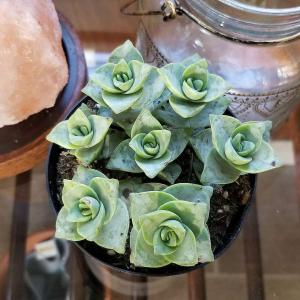文章
Dummer. ゛☀
2017年10月02日

Scientific Name
Crassula ovata (Miller) Druce
Common Names
Money Tree, Money Plant, Jade Plant, Jade Tree, Friendship Tree, Lucky Plant, Dollar Plant, Pink Joy
Synonyms
Crassula argentea, Crassula portulacea, Crassula obliqua, Crassula articulata, Crassula nitida, Crassula lucens, Cotyledon ovata, Cotyledon lutea, Toelkenia ovata
Scientific Classification
Family: Crassulaceae
Subfamily: Crassuloideae
Genus: Crassula
Description
Crassula ovata is a large well-branched, compact, rounded, evergreen shrub, up to 6 feet (180 cm) tall with glossy, dark grey-green, oval, succulent leaves and rounded heads of white to pink star-shaped flowers in early spring. The stem is stout and gnarled and gives the impression of great age, and its branches are also short and stubby but well-proportioned. Branches are succulent, grey-green in color and in older specimens the bark peels in horizontal brownish strips. The leaves are up to 2 inches (50 mm) long and up to 1.5 inches (3.8 cm) wide, egg-shaped to elliptic, often with a red margin and a somewhat pointed end. They are in opposite pairs, the one pair arranged at right angles to the next, and they are clustered towards the ends of the branches.
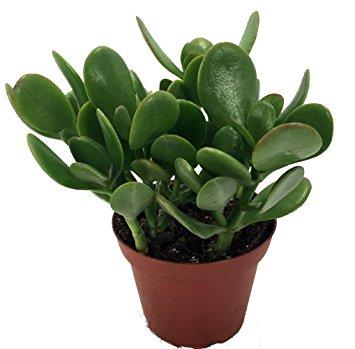
Hardiness
USDA hardiness zone 9b to 11a: from 25 °F (−3.9 °C) to 45 °F (+7.2 °C).
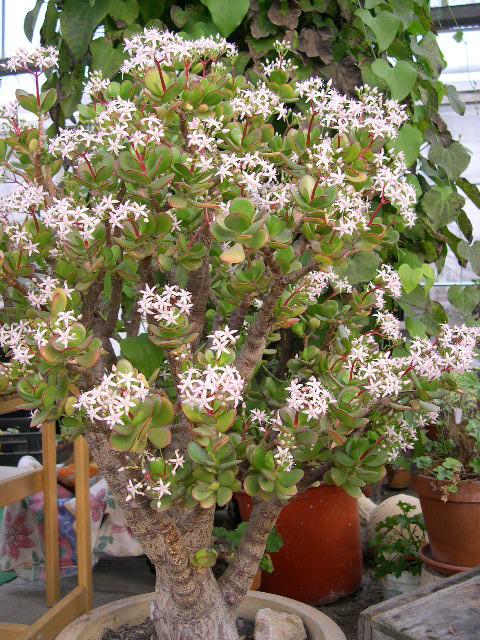
How to Grow and Care
Easy to grow in container, best in full sun but will tolerate part sun. It need well-drained soil with a neutral pH. Water regularly form spring to autumn and allow soil to dry out before watering again. During the winter months, water only enough to keep the leaves from shriveling. Most common reason for failure is overwatering. Propagating is achieved with leaf or stem cuttings which are placed into a soil mix, then wait until they show some growth… – See more at: How to Grow and Care for Jade Plant (Crassula ovata).
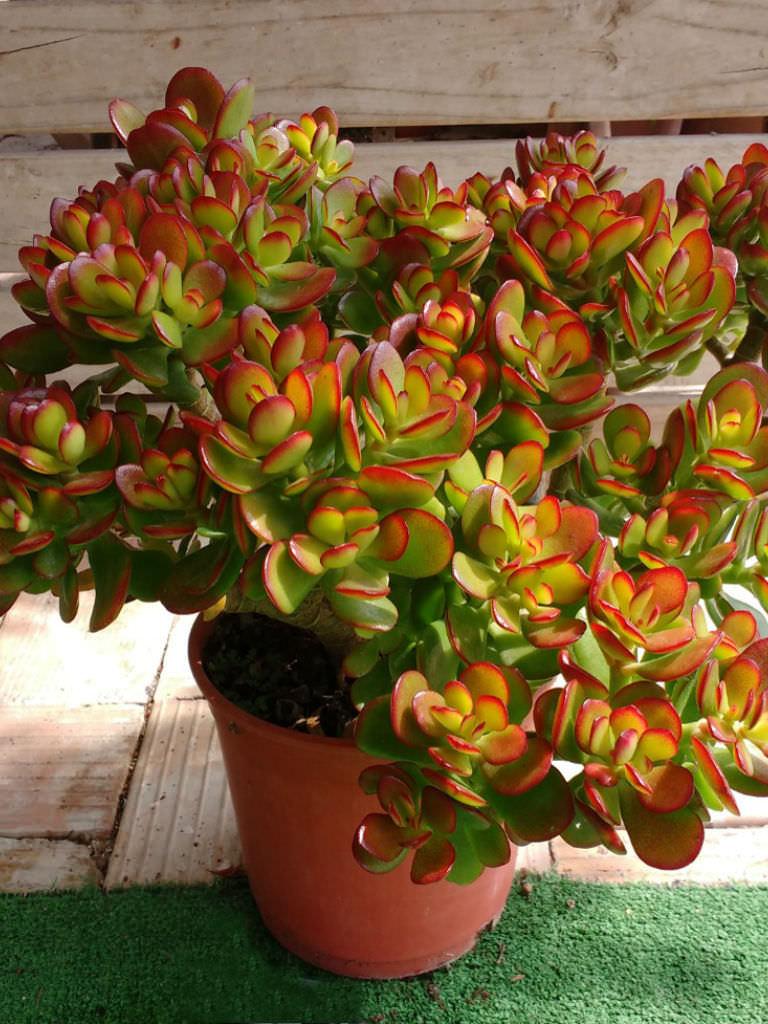
Uses
Crassula ovata is a popular good luck charm in Asia thought to activate financial energies. This beautiful succulent has vibrant green leaves symbolic of growth and renewal, closely resembling jade coins, symbolic of wealth and prosperity. It is a traditional gift for businesses and many business owners place a Jade Plant near the entrance of their restaurants or shops, or in a southeast location to bring prosperity and success… – See more at: Jade Plant for Good Luck, Prosperity and Friendship.
Jade Plant is recommended for warts in folk remedies. A leaf is cut open and the moist flesh is bound over the wart for a series of days. If the treatment is successful, the wart falls off after prolonged exposure. It is also used as a treatment for nausea, and in Africa it is used to treat epilepsy, corns, diarrhea, and to purge the intestines…. – See more at: Uses of Jade Plant in Folk Medicine.
Origin
Native to South Africa and Mozambique.
Crassula ovata (Miller) Druce
Common Names
Money Tree, Money Plant, Jade Plant, Jade Tree, Friendship Tree, Lucky Plant, Dollar Plant, Pink Joy
Synonyms
Crassula argentea, Crassula portulacea, Crassula obliqua, Crassula articulata, Crassula nitida, Crassula lucens, Cotyledon ovata, Cotyledon lutea, Toelkenia ovata
Scientific Classification
Family: Crassulaceae
Subfamily: Crassuloideae
Genus: Crassula
Description
Crassula ovata is a large well-branched, compact, rounded, evergreen shrub, up to 6 feet (180 cm) tall with glossy, dark grey-green, oval, succulent leaves and rounded heads of white to pink star-shaped flowers in early spring. The stem is stout and gnarled and gives the impression of great age, and its branches are also short and stubby but well-proportioned. Branches are succulent, grey-green in color and in older specimens the bark peels in horizontal brownish strips. The leaves are up to 2 inches (50 mm) long and up to 1.5 inches (3.8 cm) wide, egg-shaped to elliptic, often with a red margin and a somewhat pointed end. They are in opposite pairs, the one pair arranged at right angles to the next, and they are clustered towards the ends of the branches.

Hardiness
USDA hardiness zone 9b to 11a: from 25 °F (−3.9 °C) to 45 °F (+7.2 °C).

How to Grow and Care
Easy to grow in container, best in full sun but will tolerate part sun. It need well-drained soil with a neutral pH. Water regularly form spring to autumn and allow soil to dry out before watering again. During the winter months, water only enough to keep the leaves from shriveling. Most common reason for failure is overwatering. Propagating is achieved with leaf or stem cuttings which are placed into a soil mix, then wait until they show some growth… – See more at: How to Grow and Care for Jade Plant (Crassula ovata).

Uses
Crassula ovata is a popular good luck charm in Asia thought to activate financial energies. This beautiful succulent has vibrant green leaves symbolic of growth and renewal, closely resembling jade coins, symbolic of wealth and prosperity. It is a traditional gift for businesses and many business owners place a Jade Plant near the entrance of their restaurants or shops, or in a southeast location to bring prosperity and success… – See more at: Jade Plant for Good Luck, Prosperity and Friendship.
Jade Plant is recommended for warts in folk remedies. A leaf is cut open and the moist flesh is bound over the wart for a series of days. If the treatment is successful, the wart falls off after prolonged exposure. It is also used as a treatment for nausea, and in Africa it is used to treat epilepsy, corns, diarrhea, and to purge the intestines…. – See more at: Uses of Jade Plant in Folk Medicine.
Origin
Native to South Africa and Mozambique.
8
9
老王001:八宝树
文章
Dummer. ゛☀
2017年10月02日

Jade Plant (Crassula ovata) is recommended for warts in folk medicine. A leaf is cut open and the moist flesh is bound over the wart for a series of days. If the treatment is successful, the wart falls off after prolonged exposure.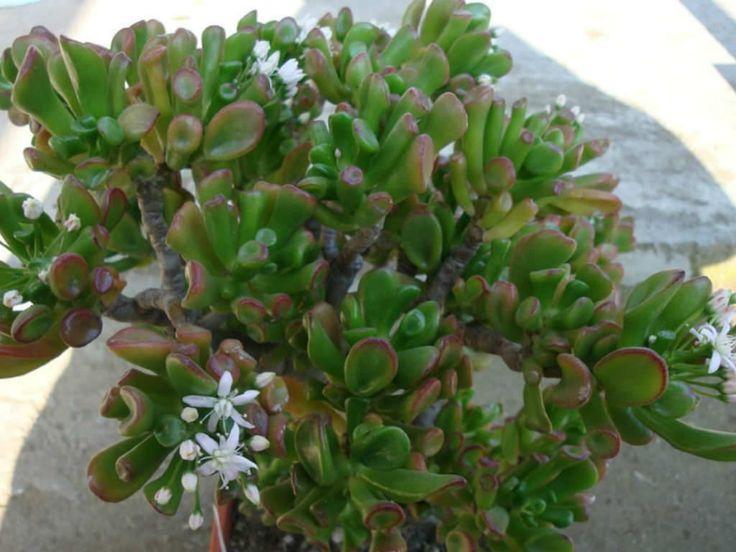
Jade Plant is also used as a treatment for nausea, and in Africa it is used to treat epilepsy, corns, diarrhea, and to purge the intestines. The Khoi and other Africans used the roots for food, grated and cooked, eaten with thick milk. They also used the leaves for medicinal purposes. The leaves were boiled in milk and used to treat epilepsy and corns, as a purgative and as a remedy for diarrhea.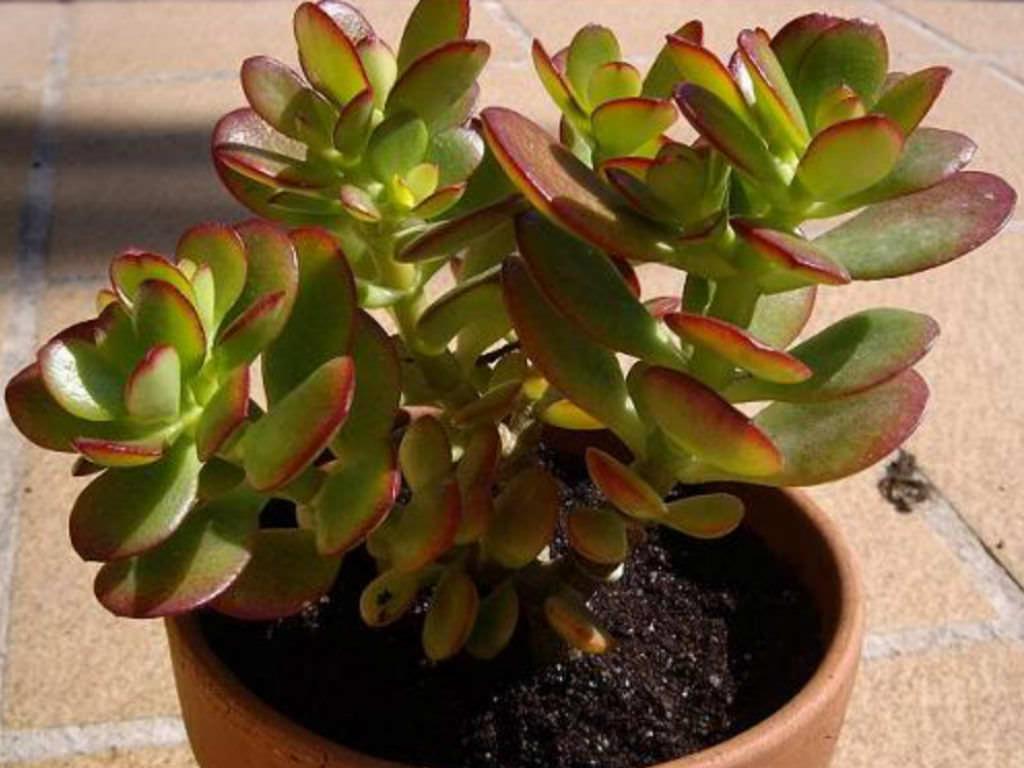
The Feng Shui masters believe that Jade Plants have calming effects.

Jade Plant is also used as a treatment for nausea, and in Africa it is used to treat epilepsy, corns, diarrhea, and to purge the intestines. The Khoi and other Africans used the roots for food, grated and cooked, eaten with thick milk. They also used the leaves for medicinal purposes. The leaves were boiled in milk and used to treat epilepsy and corns, as a purgative and as a remedy for diarrhea.

The Feng Shui masters believe that Jade Plants have calming effects.

1
1
文章
Dummer. ゛☀
2017年10月02日

Scientific Name
Crassula capitella Thunb.
Common Names
Campfire Plant, Saint Andrew’s Cross
Synonyms
Crassula albanensis, Crassula capitellata, Crassula impressa, Crassula paniculata, Crassula rufopunctata, Crassula spicata, Crassula subbifera, Globulea impressa, Globulea paniculata, Purgosea capitellata, Purgosea spicata, Turgosea capitella
Scientific Classification
Family: Crassulaceae
Subfamily: Crassuloideae
Genus: Crassula
Description
Crassula capitella is a branching perennial succulent with fleshy propeller-like leaves that mature from bright lime green to bright red. Grows prostrate, forming mats up to 6 inches (15 cm) tall and up to 3.3 feet (1 m) wide. Blooms in clusters of white flowers, up to 0.25 inches (6 mm) in diameter.
How to Grow and Care
Crassula are easy to grow, but they are susceptible to mealy bugs and fungal diseases. As with all succulents, overwatering is sure to be fatal, so err on the side of too dry rather than too wet. Never let your Crassula sit in water. If you water from beneath by letting the plant sit in a saucer of water, make sure to pour off any excess water after a few minutes.
Repot as needed, preferably during the warm season. To repot a succulent, make sure the soil is dry before repotting, then gently remove the pot. Knock away the old soil from the roots, making sure to remove any rotted or dead roots in the process. Treat any cuts with a fungicide. Place the plant in its new pot and backfill with potting soil, spreading the roots out as you repot.
Crassula capitella Thunb.
Common Names
Campfire Plant, Saint Andrew’s Cross
Synonyms
Crassula albanensis, Crassula capitellata, Crassula impressa, Crassula paniculata, Crassula rufopunctata, Crassula spicata, Crassula subbifera, Globulea impressa, Globulea paniculata, Purgosea capitellata, Purgosea spicata, Turgosea capitella

Scientific Classification
Family: Crassulaceae
Subfamily: Crassuloideae
Genus: Crassula

Description
Crassula capitella is a branching perennial succulent with fleshy propeller-like leaves that mature from bright lime green to bright red. Grows prostrate, forming mats up to 6 inches (15 cm) tall and up to 3.3 feet (1 m) wide. Blooms in clusters of white flowers, up to 0.25 inches (6 mm) in diameter.

How to Grow and Care
Crassula are easy to grow, but they are susceptible to mealy bugs and fungal diseases. As with all succulents, overwatering is sure to be fatal, so err on the side of too dry rather than too wet. Never let your Crassula sit in water. If you water from beneath by letting the plant sit in a saucer of water, make sure to pour off any excess water after a few minutes.

Repot as needed, preferably during the warm season. To repot a succulent, make sure the soil is dry before repotting, then gently remove the pot. Knock away the old soil from the roots, making sure to remove any rotted or dead roots in the process. Treat any cuts with a fungicide. Place the plant in its new pot and backfill with potting soil, spreading the roots out as you repot.
0
2
文章
Dummer. ゛☀
2017年10月02日

Scientific Name
Crassula capitella ‘Campfire’
Common Names
Campfire Crassula
Synonyms
Crassula ‘Blaze’, Crassula ‘Flame’
Scientific Classification
Family: Crassulaceae
Subfamily: Crassuloideae
Genus: Crassula
Description
Crassula capitella ‘Campfire’ is a branching succulent plant with fleshy propeller-like leaves that mature from light green to bright red. Grows prostrate, forming mats about 6 inches (15 cm) tall and up to 3 feet (90 cm) wide. Clusters of white flowers rest on the leaves in the summer.
How to Grow and Care
Crassula are easy to grow, but they are susceptible to mealy bugs and fungal diseases. As with all succulents, overwatering is sure to be fatal, so err on the side of too dry rather than too wet. Never let your Crassula sit in water. If you water from beneath by letting the plant sit in a saucer of water, make sure to pour off any excess water after a few minutes.
Repot as needed, preferably during the warm season. To repot a succulent, make sure the soil is dry before repotting, then gently remove the pot. Knock away the old soil from the roots, making sure to remove any rotted or dead roots in the process. Treat any cuts with a fungicide. Place the plant in its new pot and backfill with potting soil, spreading the roots out as you repot. Leave the plant dry for a week or so, then begin to water lightly to reduce the risk of root rot.
Crassula are generally started by division, offsets or leaf cuttings. Plants can be easily propagated from a single leaf: sprout leaves by placing them into a succulent or cacti mix, then covering the dish until they sprout.
Crassula capitella ‘Campfire’
Common Names
Campfire Crassula
Synonyms
Crassula ‘Blaze’, Crassula ‘Flame’
Scientific Classification
Family: Crassulaceae
Subfamily: Crassuloideae
Genus: Crassula

Description
Crassula capitella ‘Campfire’ is a branching succulent plant with fleshy propeller-like leaves that mature from light green to bright red. Grows prostrate, forming mats about 6 inches (15 cm) tall and up to 3 feet (90 cm) wide. Clusters of white flowers rest on the leaves in the summer.

How to Grow and Care
Crassula are easy to grow, but they are susceptible to mealy bugs and fungal diseases. As with all succulents, overwatering is sure to be fatal, so err on the side of too dry rather than too wet. Never let your Crassula sit in water. If you water from beneath by letting the plant sit in a saucer of water, make sure to pour off any excess water after a few minutes.

Repot as needed, preferably during the warm season. To repot a succulent, make sure the soil is dry before repotting, then gently remove the pot. Knock away the old soil from the roots, making sure to remove any rotted or dead roots in the process. Treat any cuts with a fungicide. Place the plant in its new pot and backfill with potting soil, spreading the roots out as you repot. Leave the plant dry for a week or so, then begin to water lightly to reduce the risk of root rot.

Crassula are generally started by division, offsets or leaf cuttings. Plants can be easily propagated from a single leaf: sprout leaves by placing them into a succulent or cacti mix, then covering the dish until they sprout.
1
2
文章
Dummer. ゛☀
2017年10月02日

Scientific Name
Crassula ‘Buddha’s Temple’
Common Names
Buddha’s Temple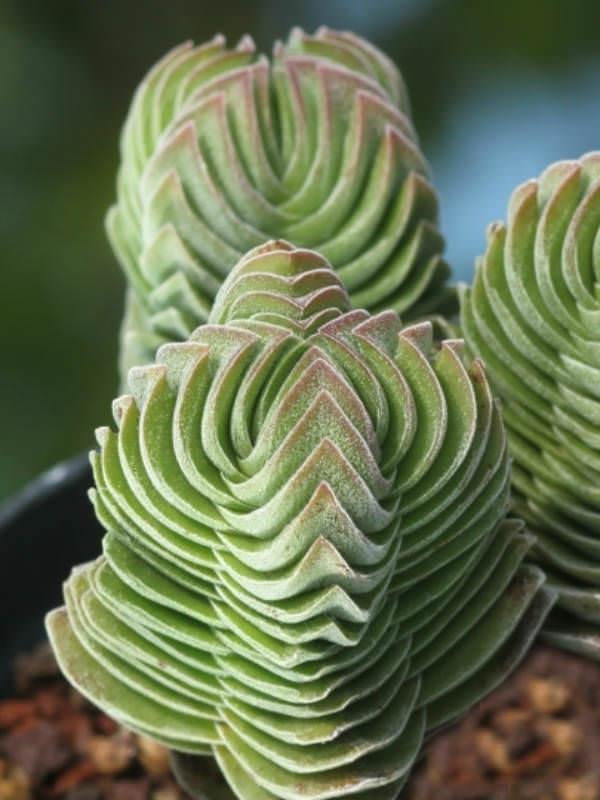
Synonyms
Crassula ‘Kimnachi’, Crassula ‘Myron Kimnach’
Scientific Classification
Family: Crassulaceae
Subfamily: Crassuloideae
Genus: Crassula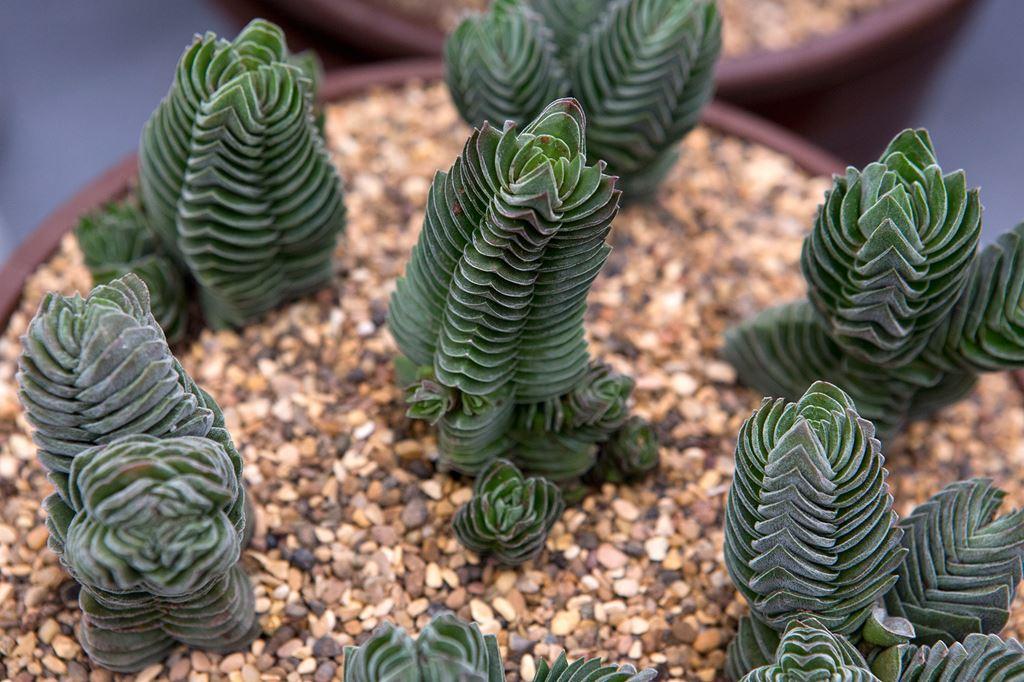
Description
Crassula ‘Buddha’s Temple’ is a very interesting succulent plant. In time it will grow about up to 6 inches (15 cm) tall and start branching at varying levels from the sides of each column. The flat, thin leaves are silvery-grey to grayish-green in color. They are stacked tightly and folded up at the edges, forming a perfectly square column about 1 inch (2.5 cm) in diameter. It develops the most wonderful spherical red, orange or white flower stuck to the top of the plant.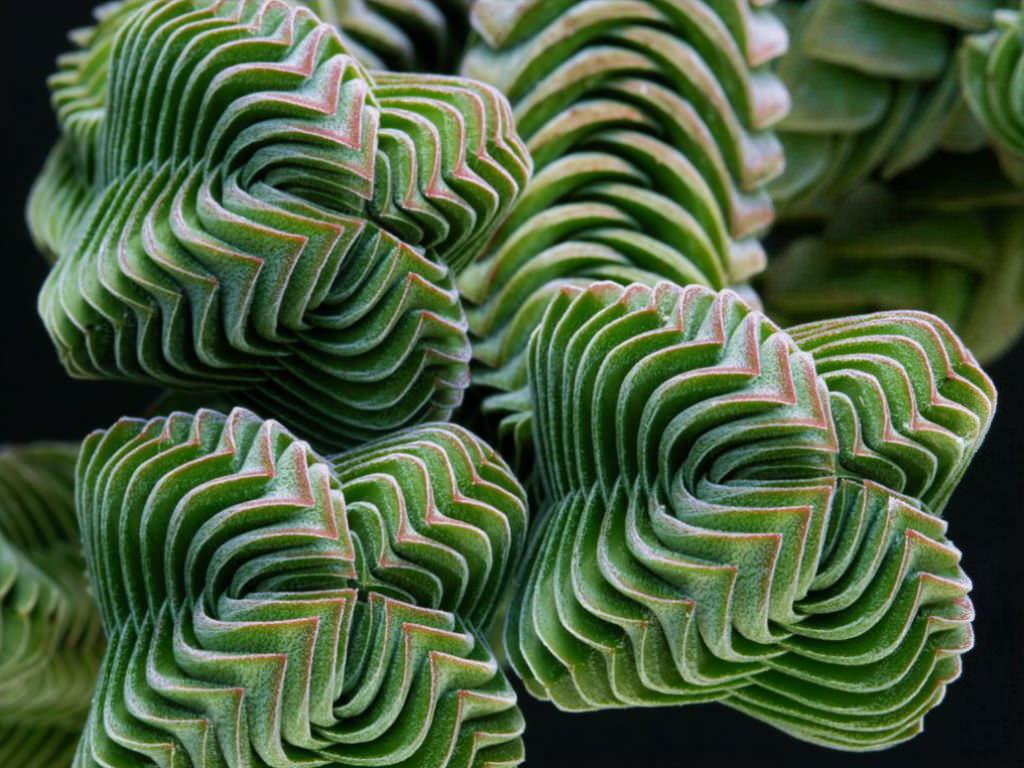
How to Grow and Care
Crassula are easy to grow, but they are susceptible to mealy bugs and fungal diseases. As with all succulents, overwatering is sure to be fatal, so err on the side of too dry rather than too wet. Never let your Crassula sit in water. If you water from beneath by letting the plant sit in a saucer of water, make sure to pour off any excess water after a few minutes. Crassula are generally started by division, offsets or leaf cuttings. Plants can be easily propagated from a single leaf: sprout leaves by placing them into a succulent or cacti mix, then covering the dish until they sprout. Repot as needed, preferably during the warm season.
Crassula ‘Buddha’s Temple’
Common Names
Buddha’s Temple

Synonyms
Crassula ‘Kimnachi’, Crassula ‘Myron Kimnach’
Scientific Classification
Family: Crassulaceae
Subfamily: Crassuloideae
Genus: Crassula

Description
Crassula ‘Buddha’s Temple’ is a very interesting succulent plant. In time it will grow about up to 6 inches (15 cm) tall and start branching at varying levels from the sides of each column. The flat, thin leaves are silvery-grey to grayish-green in color. They are stacked tightly and folded up at the edges, forming a perfectly square column about 1 inch (2.5 cm) in diameter. It develops the most wonderful spherical red, orange or white flower stuck to the top of the plant.

How to Grow and Care
Crassula are easy to grow, but they are susceptible to mealy bugs and fungal diseases. As with all succulents, overwatering is sure to be fatal, so err on the side of too dry rather than too wet. Never let your Crassula sit in water. If you water from beneath by letting the plant sit in a saucer of water, make sure to pour off any excess water after a few minutes. Crassula are generally started by division, offsets or leaf cuttings. Plants can be easily propagated from a single leaf: sprout leaves by placing them into a succulent or cacti mix, then covering the dish until they sprout. Repot as needed, preferably during the warm season.
3
2
文章
Dummer. ゛☀
2017年10月02日

Scientific Name
Crassula sarcocaulis Eckl. & Zeyh.
Common Names
Bonsai Crassula, Bonsai Jade
Synonyms
Crassula lignosa, Crassula parvisepala, Crassula sarcocaulis subsp. sarcocaulis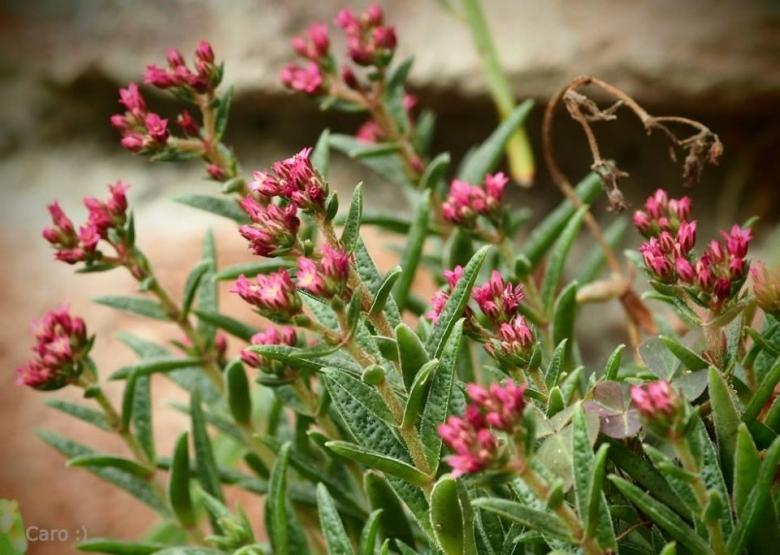
Scientific Classification
Family: Crassulaceae
Subfamily: Crassuloideae
Genus: Crassula
Description
Crassula sarcocaulis is a low growing shrub, up to 2 feet (60 cm) tall, with a fat gnarly trunk and stems with peeling bark bearing narrow green succulent leaves and attractive terminal flower clusters in summer. The flowers start as small pink flower buds that open to show off bell-shaped pale-pink flowers.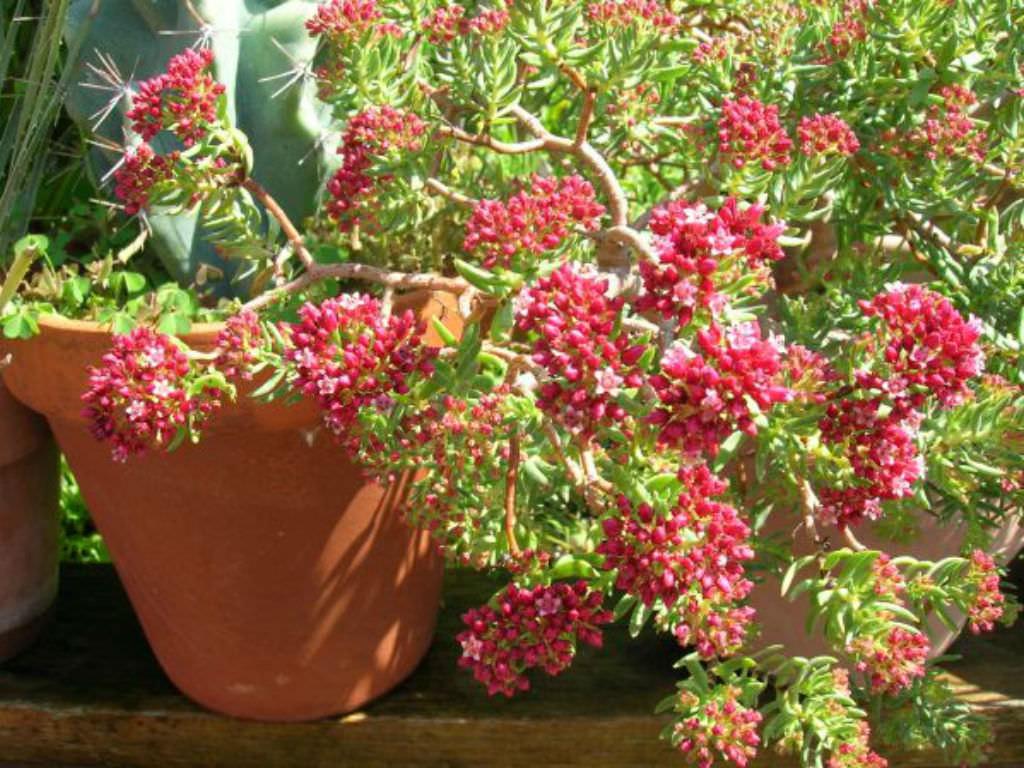
How to Grow and Care
Crassula are easy to grow, but they are susceptible to mealy bugs and fungal diseases. As with all succulents, overwatering is sure to be fatal, so err on the side of too dry rather than too wet. Never let your Crassula sit in water. If you water from beneath by letting the plant sit in a saucer of water, make sure to pour off any excess water after a few minutes.
Crassula are generally started by division, offsets or leaf cuttings. Plants can be easily propagated from a single leaf: sprout leaves by placing them into a succulent or cacti mix, then covering the dish until they sprout.
Repot as needed, preferably during the warm season. To repot a succulent, make sure the soil is dry before repotting, then gently remove the pot. Knock away the old soil from the roots, making sure to remove any rotted or dead roots in the process. Treat any cuts with a fungicide. Place the plant in its new pot and backfill with potting soil, spreading the roots out as you repot.
Crassula sarcocaulis Eckl. & Zeyh.
Common Names
Bonsai Crassula, Bonsai Jade
Synonyms
Crassula lignosa, Crassula parvisepala, Crassula sarcocaulis subsp. sarcocaulis

Scientific Classification
Family: Crassulaceae
Subfamily: Crassuloideae
Genus: Crassula

Description
Crassula sarcocaulis is a low growing shrub, up to 2 feet (60 cm) tall, with a fat gnarly trunk and stems with peeling bark bearing narrow green succulent leaves and attractive terminal flower clusters in summer. The flowers start as small pink flower buds that open to show off bell-shaped pale-pink flowers.

How to Grow and Care
Crassula are easy to grow, but they are susceptible to mealy bugs and fungal diseases. As with all succulents, overwatering is sure to be fatal, so err on the side of too dry rather than too wet. Never let your Crassula sit in water. If you water from beneath by letting the plant sit in a saucer of water, make sure to pour off any excess water after a few minutes.
Crassula are generally started by division, offsets or leaf cuttings. Plants can be easily propagated from a single leaf: sprout leaves by placing them into a succulent or cacti mix, then covering the dish until they sprout.

Repot as needed, preferably during the warm season. To repot a succulent, make sure the soil is dry before repotting, then gently remove the pot. Knock away the old soil from the roots, making sure to remove any rotted or dead roots in the process. Treat any cuts with a fungicide. Place the plant in its new pot and backfill with potting soil, spreading the roots out as you repot.
0
0
文章
Dummer. ゛☀
2017年10月01日

Scientific Name
Crassula arborescens (Mill.) Willd.
Common Names
Silver Dollar, Silver Dollar Plant, Silver Dollar Jade, Silver Jade Plant, Chinese Jade, Tree Crassula, Beestebul, Money Plant, Round-Leaved Crassula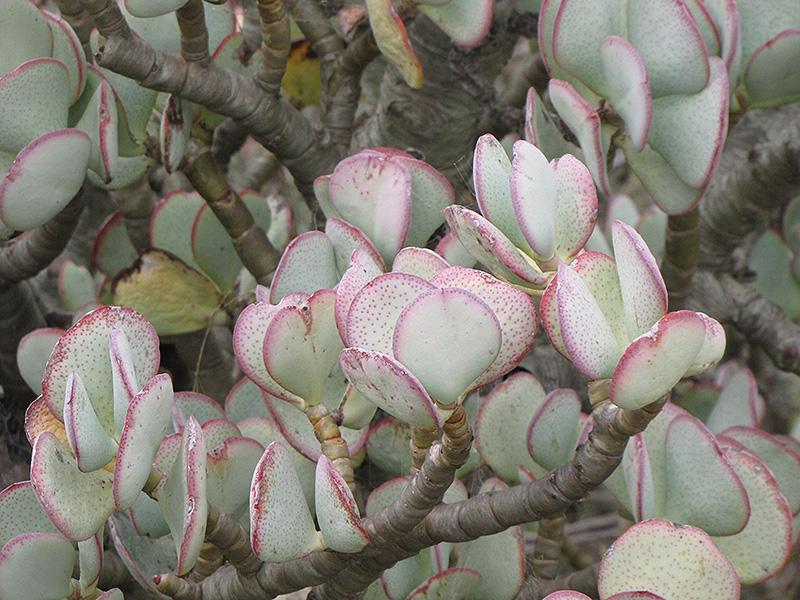
Synonyms
Cotyledon arborescens (basionym), Crassula arborescens subsp. arborescens, Cotyledon punctata, Crassula arborea, Crassula cotyledon, Crassula cotyledonifolia
Scientific Classification
Family: Crassulaceae
Subfamily: Crassuloideae
Genus: Crassula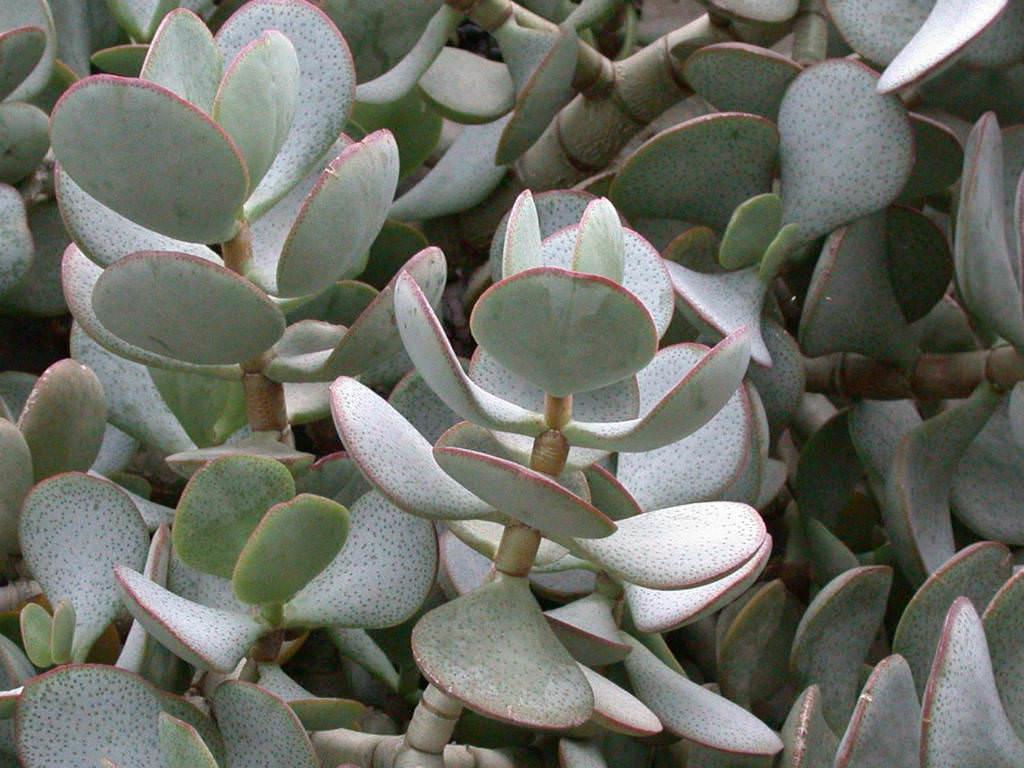
Description
Crassula arborescens is a many branched succulent shrub or small tree, up to 4 feet (1.2 m) tall. It has rounded, fat, silver-gray, up to 3 inches (7.6 cm) long leaves that are often edged maroon and have reddish spots on the upper surface. The star-like flowers are pinkish white in color.
How to Grow and Care
Crassula are easy to grow, but they are susceptible to mealy bugs and fungal diseases. As with all succulents, overwatering is sure to be fatal, so err on the side of too dry rather than too wet. Never let your Crassula sit in water. If you water from beneath by letting the plant sit in a saucer of water, make sure to pour off any excess water after a few minutes.
Repot as needed, preferably during the warm season. To repot a succulent, make sure the soil is dry before repotting, then gently remove the pot.
Crassula are generally started by division, offsets or leaf cuttings. Plants can be easily propagated from a single leaf: sprout leaves by placing them into a succulent or cacti mix, then covering the dish until they sprout.
Crassula arborescens (Mill.) Willd.
Common Names
Silver Dollar, Silver Dollar Plant, Silver Dollar Jade, Silver Jade Plant, Chinese Jade, Tree Crassula, Beestebul, Money Plant, Round-Leaved Crassula

Synonyms
Cotyledon arborescens (basionym), Crassula arborescens subsp. arborescens, Cotyledon punctata, Crassula arborea, Crassula cotyledon, Crassula cotyledonifolia
Scientific Classification
Family: Crassulaceae
Subfamily: Crassuloideae
Genus: Crassula

Description
Crassula arborescens is a many branched succulent shrub or small tree, up to 4 feet (1.2 m) tall. It has rounded, fat, silver-gray, up to 3 inches (7.6 cm) long leaves that are often edged maroon and have reddish spots on the upper surface. The star-like flowers are pinkish white in color.
How to Grow and Care
Crassula are easy to grow, but they are susceptible to mealy bugs and fungal diseases. As with all succulents, overwatering is sure to be fatal, so err on the side of too dry rather than too wet. Never let your Crassula sit in water. If you water from beneath by letting the plant sit in a saucer of water, make sure to pour off any excess water after a few minutes.

Repot as needed, preferably during the warm season. To repot a succulent, make sure the soil is dry before repotting, then gently remove the pot.
Crassula are generally started by division, offsets or leaf cuttings. Plants can be easily propagated from a single leaf: sprout leaves by placing them into a succulent or cacti mix, then covering the dish until they sprout.
2
3
文章
Dummer. ゛☀
2017年10月01日

Scientific Name
Crassula barbata Thunb.
Common Names
Bearded-leaved Crassula
Synonyms
Crassula barbata subsp. barbata, Crassula lettyae, Purgosea barbata
Scientific Classification
Family: Crassulaceae
Subfamily: Crassuloideae
Genus: Crassula
Description
Crassula barbata is a biennial or annual rosette-forming succulent, up to 1 foot (30 cm) in height when flowering, usually with one rosette with leaves spirally arranged and old ones remaining attached to stems. Leaves are up to 2 inches (5 cm) long, up to 1.6 inches (4 cm) wide, glabrous but characteristically bearded along the truncate apex with long white spreading hairs. The spikes of small, white to pinkish flowers appear in spring. The rosette will open up as the center extends to form the tall flower stem, and after flowering it will die. Fortunately the dying rosette usually produces a number of basal rosettes which can be detached and grown on to repeat the cycle.
How to Grow and Care
Crassula are easy to grow, but they are susceptible to mealy bugs and fungal diseases. As with all succulents, overwatering is sure to be fatal, so err on the side of too dry rather than too wet. Never let your Crassula sit in water. If you water from beneath by letting the plant sit in a saucer of water, make sure to pour off any excess water after a few minutes.
Crassula are generally started by division, offsets or leaf cuttings. Plants can be easily propagated from a single leaf: sprout leaves by placing them into a succulent or cacti mix, then covering the dish until they sprout.
Repot as needed, preferably during the warm season. To repot a succulent, make sure the soil is dry before repotting, then gently remove the pot. Knock away the old soil from the roots, making sure to remove any rotted or dead roots in the process. Treat any cuts with a fungicide. Place the plant in its new pot and backfill with potting soil, spreading the roots out as you repot.
Crassula barbata Thunb.
Common Names
Bearded-leaved Crassula
Synonyms
Crassula barbata subsp. barbata, Crassula lettyae, Purgosea barbata

Scientific Classification
Family: Crassulaceae
Subfamily: Crassuloideae
Genus: Crassula
Description
Crassula barbata is a biennial or annual rosette-forming succulent, up to 1 foot (30 cm) in height when flowering, usually with one rosette with leaves spirally arranged and old ones remaining attached to stems. Leaves are up to 2 inches (5 cm) long, up to 1.6 inches (4 cm) wide, glabrous but characteristically bearded along the truncate apex with long white spreading hairs. The spikes of small, white to pinkish flowers appear in spring. The rosette will open up as the center extends to form the tall flower stem, and after flowering it will die. Fortunately the dying rosette usually produces a number of basal rosettes which can be detached and grown on to repeat the cycle.

How to Grow and Care
Crassula are easy to grow, but they are susceptible to mealy bugs and fungal diseases. As with all succulents, overwatering is sure to be fatal, so err on the side of too dry rather than too wet. Never let your Crassula sit in water. If you water from beneath by letting the plant sit in a saucer of water, make sure to pour off any excess water after a few minutes.
Crassula are generally started by division, offsets or leaf cuttings. Plants can be easily propagated from a single leaf: sprout leaves by placing them into a succulent or cacti mix, then covering the dish until they sprout.

Repot as needed, preferably during the warm season. To repot a succulent, make sure the soil is dry before repotting, then gently remove the pot. Knock away the old soil from the roots, making sure to remove any rotted or dead roots in the process. Treat any cuts with a fungicide. Place the plant in its new pot and backfill with potting soil, spreading the roots out as you repot.
1
1
文章
Dummer. ゛☀
2017年10月01日

Scientific Name
Crassula rupestris Thunb.
Common Names
Kebab Bush, Concertina Bush, Bead Vine, Rosary Vine
Synonyms
Crassula rupestris subsp. rupestris, Crassula monticola, Purgosea rupestris
Scientific Classification
Family: Crassulaceae
Subfamily: Crassuloideae
Genus: Crassula
Description
Crassula rupestris is a much-branched, succulent, perennial subshrub, up to 12 inches (30 cm) tall and wide (up to 3 feet/1 m tall in nature). The stems are thin, fleshy near the growing tip, but rather woody lower down. Leaves are small, thick, opposite, ovate and lanceolate in shape, up to 1 inch (2.5 cm) long and grayish in color (during the summer months the leaf margins turn a brilliant red or yellow). Flowers are grouped in clusters, deep pink to pale pink, star-shaped and up to 0.25 inch (6 mm) across.
Hardiness
USDA hardiness zone 9b to 11b: from 25 °F (−3.9 °C) to 50 °F (+10 °C).
How to Grow and Care
Crassula are easy to grow, but they are susceptible to mealy bugs and fungal diseases. As with all succulents, overwatering is sure to be fatal, so err on the side of too dry rather than too wet. Never let your Crassula sit in water. If you water from beneath by letting the plant sit in a saucer of water, make sure to pour off any excess water after a few minutes.
Crassula are generally started by division, offsets or leaf cuttings. Plants can be easily propagated from a single leaf: sprout leaves by placing them into a succulent or cacti mix, then covering the dish until they sprout.
Crassula rupestris Thunb.
Common Names
Kebab Bush, Concertina Bush, Bead Vine, Rosary Vine

Synonyms
Crassula rupestris subsp. rupestris, Crassula monticola, Purgosea rupestris
Scientific Classification
Family: Crassulaceae
Subfamily: Crassuloideae
Genus: Crassula

Description
Crassula rupestris is a much-branched, succulent, perennial subshrub, up to 12 inches (30 cm) tall and wide (up to 3 feet/1 m tall in nature). The stems are thin, fleshy near the growing tip, but rather woody lower down. Leaves are small, thick, opposite, ovate and lanceolate in shape, up to 1 inch (2.5 cm) long and grayish in color (during the summer months the leaf margins turn a brilliant red or yellow). Flowers are grouped in clusters, deep pink to pale pink, star-shaped and up to 0.25 inch (6 mm) across.

Hardiness
USDA hardiness zone 9b to 11b: from 25 °F (−3.9 °C) to 50 °F (+10 °C).
How to Grow and Care
Crassula are easy to grow, but they are susceptible to mealy bugs and fungal diseases. As with all succulents, overwatering is sure to be fatal, so err on the side of too dry rather than too wet. Never let your Crassula sit in water. If you water from beneath by letting the plant sit in a saucer of water, make sure to pour off any excess water after a few minutes.

Crassula are generally started by division, offsets or leaf cuttings. Plants can be easily propagated from a single leaf: sprout leaves by placing them into a succulent or cacti mix, then covering the dish until they sprout.
1
0
文章
Dummer. ゛☀
2017年10月01日

Scientific Name
Crassula rupestris var. monticola
Common Names
Rosary Vine, Kebab Bush, Concertina Bush, Bead Vine
Synonyms
Crassula monticola
Scientific Classification
Family: Crassulaceae
Subfamily: Crassuloideae
Genus: Crassula
Description
Crassula rupestris is a much-branched, succulent, perennial subshrub, up to 12 inches (30 cm) tall and wide (up to 3 feet/1 m tall in nature). The stems are thin, fleshy near the growing tip, but rather woody lower down. Leaves are small, thick, opposite, ovate and lanceolate in shape, up to 1 inch (2.5 cm) long and grayish in color (during the summer months the leaf margins turn a brilliant red or yellow). Crassula rupestris var. monticola is a wonderful variety with slightly smaller, thick, rounded leaves. Flowers are grouped in clusters, deep pink to pale pink, star-shaped and up to 0.25 inch (6 mm) across.
Hardiness
USDA hardiness zone 9b to 11b: from 25 °F (−3.9 °C) to 50 °F (+10 °C).
How to Grow and Care
Crassula are easy to grow, but they are susceptible to mealy bugs and fungal diseases. As with all succulents, overwatering is sure to be fatal, so err on the side of too dry rather than too wet. Never let your Crassula sit in water. If you water from beneath by letting the plant sit in a saucer of water, make sure to pour off any excess water after a few minutes.
Crassula are generally started by division, offsets or leaf cuttings. Plants can be easily propagated from a single leaf: sprout leaves by placing them into a succulent or cacti mix, then covering the dish until they sprout. Repot as needed, preferably during the warm season.
Crassula rupestris var. monticola
Common Names
Rosary Vine, Kebab Bush, Concertina Bush, Bead Vine

Synonyms
Crassula monticola
Scientific Classification
Family: Crassulaceae
Subfamily: Crassuloideae
Genus: Crassula

Description
Crassula rupestris is a much-branched, succulent, perennial subshrub, up to 12 inches (30 cm) tall and wide (up to 3 feet/1 m tall in nature). The stems are thin, fleshy near the growing tip, but rather woody lower down. Leaves are small, thick, opposite, ovate and lanceolate in shape, up to 1 inch (2.5 cm) long and grayish in color (during the summer months the leaf margins turn a brilliant red or yellow). Crassula rupestris var. monticola is a wonderful variety with slightly smaller, thick, rounded leaves. Flowers are grouped in clusters, deep pink to pale pink, star-shaped and up to 0.25 inch (6 mm) across.

Hardiness
USDA hardiness zone 9b to 11b: from 25 °F (−3.9 °C) to 50 °F (+10 °C).
How to Grow and Care
Crassula are easy to grow, but they are susceptible to mealy bugs and fungal diseases. As with all succulents, overwatering is sure to be fatal, so err on the side of too dry rather than too wet. Never let your Crassula sit in water. If you water from beneath by letting the plant sit in a saucer of water, make sure to pour off any excess water after a few minutes.

Crassula are generally started by division, offsets or leaf cuttings. Plants can be easily propagated from a single leaf: sprout leaves by placing them into a succulent or cacti mix, then covering the dish until they sprout. Repot as needed, preferably during the warm season.
1
3
文章
Dummer. ゛☀
2017年10月01日

Scientific Name
Crassula barklyi N.E.Br.
Common Names
Rattlesnake Tail, Bandaged Finger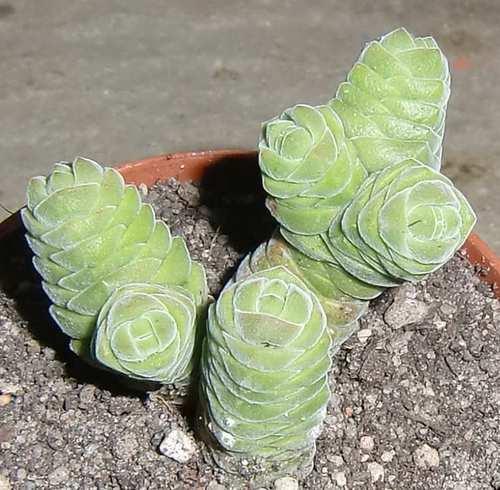
Synonyms
Crassula teres
Scientific Classification
Family: Crassulaceae
Subfamily: Crassuloideae
Genus: Crassula
Description
Crassula barklyi is a perennial, dwarf succulent shrub with erect or rarely decumbent stems. It branches at the base into several attractive finger-like growths. It is very slow growing but will reach up to 4 inches (10 cm). The stem is covered neatly and smoothly by the overlapping leaves to form a short almost cylindrical column, which has something of the appearance of a tree cone. Younger branches are almost spherical and looks like grey-green rosebuds. The leaves are fleshy, depressed-ovate, concave, up to 0.2 inch (5 mm) long and up to 0.6 inch (15 mm) wide. It flowers in winter. Flowers are tiny, stemless and white in color.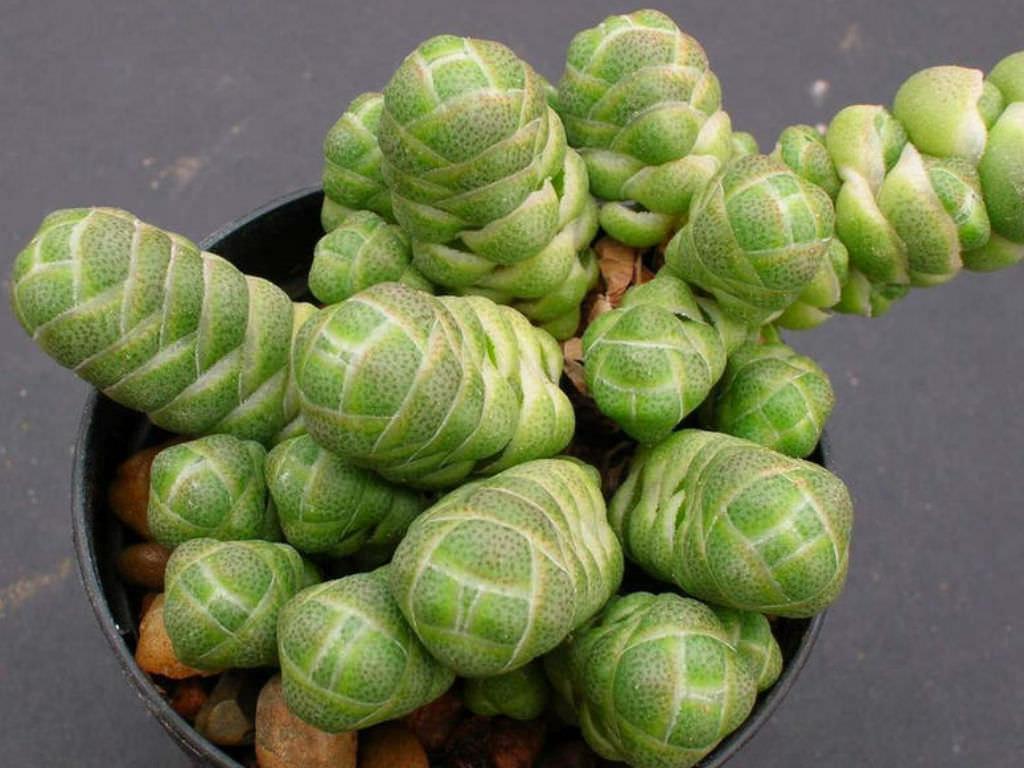
How to Grow and Care
Crassula are easy to grow, but they are susceptible to mealy bugs and fungal diseases. As with all succulents, overwatering is sure to be fatal, so err on the side of too dry rather than too wet. Never let your Crassula sit in water. If you water from beneath by letting the plant sit in a saucer of water, make sure to pour off any excess water after a few minutes. Crassula are generally started by division, offsets or leaf cuttings. Plants can be easily propagated from a single leaf: sprout leaves by placing them into a succulent or cacti mix, then covering the dish until they sprout. Repot as needed, preferably during the warm season.
Crassula barklyi N.E.Br.
Common Names
Rattlesnake Tail, Bandaged Finger

Synonyms
Crassula teres
Scientific Classification
Family: Crassulaceae
Subfamily: Crassuloideae
Genus: Crassula

Description
Crassula barklyi is a perennial, dwarf succulent shrub with erect or rarely decumbent stems. It branches at the base into several attractive finger-like growths. It is very slow growing but will reach up to 4 inches (10 cm). The stem is covered neatly and smoothly by the overlapping leaves to form a short almost cylindrical column, which has something of the appearance of a tree cone. Younger branches are almost spherical and looks like grey-green rosebuds. The leaves are fleshy, depressed-ovate, concave, up to 0.2 inch (5 mm) long and up to 0.6 inch (15 mm) wide. It flowers in winter. Flowers are tiny, stemless and white in color.

How to Grow and Care
Crassula are easy to grow, but they are susceptible to mealy bugs and fungal diseases. As with all succulents, overwatering is sure to be fatal, so err on the side of too dry rather than too wet. Never let your Crassula sit in water. If you water from beneath by letting the plant sit in a saucer of water, make sure to pour off any excess water after a few minutes. Crassula are generally started by division, offsets or leaf cuttings. Plants can be easily propagated from a single leaf: sprout leaves by placing them into a succulent or cacti mix, then covering the dish until they sprout. Repot as needed, preferably during the warm season.
0
0
文章
Dummer. ゛☀
2017年10月01日

Scientific Name
Crassula helmsii (Kirk) Cockayne
Common Names
Swamp Stonecrop, Australian Swamp Stonecrop, New Zealand Pigmyweed
Synonyms
Bulliarda recurva, Tillaea helmsii, Crassula recurva
Scientific Classification
Family: Crassulaceae
Subfamily: Crassuloideae
Genus: Crassula
Description
Crassula helmsii is a small aquatic or semiterrestrial species of succulent plant. The shoots are rather stiff, carrying narrow parallel-sided leaves in opposite pairs, each leaf being up to 1 inch (2.5 cm) long. Small white flowers with four petals are produced in summer on long stalks arising from the upper leaf axils.
How to Grow and Care
Crassula are easy to grow, but they are susceptible to mealy bugs and fungal diseases. As with all succulents, overwatering is sure to be fatal, so err on the side of too dry rather than too wet. Never let your Crassula sit in water. If you water from beneath by letting the plant sit in a saucer of water, make sure to pour off any excess water after a few minutes.
Repot as needed, preferably during the warm season. To repot a succulent, make sure the soil is dry before repotting, then gently remove the pot. Knock away the old soil from the roots, making sure to remove any rotted or dead roots in the process. Treat any cuts with a fungicide. Place the plant in its new pot and backfill with potting soil, spreading the roots out as you repot.
Crassula helmsii (Kirk) Cockayne
Common Names
Swamp Stonecrop, Australian Swamp Stonecrop, New Zealand Pigmyweed

Synonyms
Bulliarda recurva, Tillaea helmsii, Crassula recurva
Scientific Classification
Family: Crassulaceae
Subfamily: Crassuloideae
Genus: Crassula

Description
Crassula helmsii is a small aquatic or semiterrestrial species of succulent plant. The shoots are rather stiff, carrying narrow parallel-sided leaves in opposite pairs, each leaf being up to 1 inch (2.5 cm) long. Small white flowers with four petals are produced in summer on long stalks arising from the upper leaf axils.

How to Grow and Care
Crassula are easy to grow, but they are susceptible to mealy bugs and fungal diseases. As with all succulents, overwatering is sure to be fatal, so err on the side of too dry rather than too wet. Never let your Crassula sit in water. If you water from beneath by letting the plant sit in a saucer of water, make sure to pour off any excess water after a few minutes.

Repot as needed, preferably during the warm season. To repot a succulent, make sure the soil is dry before repotting, then gently remove the pot. Knock away the old soil from the roots, making sure to remove any rotted or dead roots in the process. Treat any cuts with a fungicide. Place the plant in its new pot and backfill with potting soil, spreading the roots out as you repot.
0
0
文章
Dummer. ゛☀
2017年10月01日

Scientific Name
Crassula perfoliata var. minor (Haw.) G.D.Rowley
Common Names
Airplane Plant, Propeller Plant, Red Crassula, Scarlet Paintbrush
Synonyms
Crassula falcata, Crassula perfoliata var. falcata, Crassula perfoliata subsp. falcata, Rochea falcata
Scientific Classification
Family: Crassulaceae
Subfamily: Crassuloideae
Genus: Crassula
Description
Crassula perfoliata var. minor is a succulent plant that grows to 2 feet (60 cm) tall with gray-green 4 inch (10 cm) long and 1 inch (2.5 cm) wide sickle-shaped leaves that are arranged in overlapping pairs along a usually unbranched stem. Tiny scarlet red flowers are massed together in very showy dense clusters that rise above foliage in mid summer. The flowers open slowly and last for nearly a month when in full bloom. Attractive and interesting when not in bloom but a show stopper when the bright red flowers emerge.
How to Grow and Care
Crassula are easy to grow, but they are susceptible to mealy bugs and fungal diseases. As with all succulents, overwatering is sure to be fatal, so err on the side of too dry rather than too wet. Never let your Crassula sit in water. If you water from beneath by letting the plant sit in a saucer of water, make sure to pour off any excess water after a few minutes.
Crassula are generally started by division, offsets or leaf cuttings. Plants can be easily propagated from a single leaf: sprout leaves by placing them into a succulent or cacti mix, then covering the dish until they sprout. Repot as needed, preferably during the warm season.
Crassula perfoliata var. minor (Haw.) G.D.Rowley

Common Names
Airplane Plant, Propeller Plant, Red Crassula, Scarlet Paintbrush
Synonyms
Crassula falcata, Crassula perfoliata var. falcata, Crassula perfoliata subsp. falcata, Rochea falcata
Scientific Classification
Family: Crassulaceae
Subfamily: Crassuloideae
Genus: Crassula

Description
Crassula perfoliata var. minor is a succulent plant that grows to 2 feet (60 cm) tall with gray-green 4 inch (10 cm) long and 1 inch (2.5 cm) wide sickle-shaped leaves that are arranged in overlapping pairs along a usually unbranched stem. Tiny scarlet red flowers are massed together in very showy dense clusters that rise above foliage in mid summer. The flowers open slowly and last for nearly a month when in full bloom. Attractive and interesting when not in bloom but a show stopper when the bright red flowers emerge.

How to Grow and Care
Crassula are easy to grow, but they are susceptible to mealy bugs and fungal diseases. As with all succulents, overwatering is sure to be fatal, so err on the side of too dry rather than too wet. Never let your Crassula sit in water. If you water from beneath by letting the plant sit in a saucer of water, make sure to pour off any excess water after a few minutes.

Crassula are generally started by division, offsets or leaf cuttings. Plants can be easily propagated from a single leaf: sprout leaves by placing them into a succulent or cacti mix, then covering the dish until they sprout. Repot as needed, preferably during the warm season.
0
0



